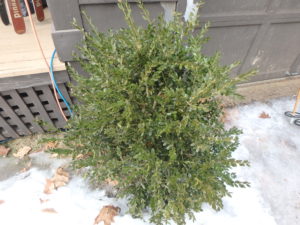Plants I Do Not Like
There are a few plants I just do not like. Yes, I’m known as the Gardening Guy and have the website to prove it (www.Gardening-Guy.com). So I should love – or at least like – all plants. But I don’t. Now, in mid-winter, it’s a good time to reflect on what we like and want to grow – and what plan to avoid.
Weigela reminds me of an elderly auntie who wears too much perfume, too much rouge, and leaves lipstick on her old fashioned glass – or any unfortunate nephew she meets up with. Of course I have never grown it, and some forms of it may be lovely. But the colors seem artificial to me, the shrub coarse. It blooms in May, and many new colors have been created in recent years, which may include some beauties.
I often use Michael Dirr’s books to inform me about woody plants. His classic is Manual of Woody Landscape Plants: Their Identification, Culture, Propagation and Uses. It is nearly 1200 pages long and tells everything you might need to know – and his opinions. Here is what he says about Weigela’s landscape value:“Best used in the shrub border, for grouping or massing; have seen it used frequently as a foundation planting in older sections of cities; really appears forlorn in the winter landscape; looks like it needs a place to hide.”
Old fashioned petunias are not my cup of tea. My mother grew them and in the beginning of the summer they looked fine. This annual plant produces flowers and makes seeds in sequence up its stem. It blooms first from the base of the plant, then grows a longer stem, and blooms again while the first blossoms make seeds. And so on.
Once the petunia has produced enough seeds to ensure the continuation of the family name, it dies. No ifs, ands or buts. My mother was not good on pruning back the spent blossoms and stems, to keep them nice looking. They got leggy and bare, then died by late summer.
The good news, for all of you with happy memories of old fashioned petunias is that plant breeders have developed petunias that don’t need to be pruned or cut back. These so called “Supertunias” are often trademarked hybrids that bloom all summer. Most have smaller blossoms, but really are quite nice and bloom all summer. There is even one called Bubblegum! I have used Supertunias in planters.
By the way, there is a book similar to Dirr’s book mentioned above. It’s Steven Still’s Manual of Herbaceous Ornamental Plants. It is over 800 pages, and equally useful. It tells you, for example, what soil a plant likes, what the roots are like, how much sun is needed– even the pH if important. I trust it more than internet info, though obviously it doesn’t get updated with new cultivar names the way blog sites do.
A perfectly nice little shrub that is used widely, especially in formal gardens is boxwood (Buxus spp.). But I don’t like it. In contrast to Weigela, this one is too austere and formal for me. And the real reason I don’t like it is this: the foliage smells like cat pee. Why grow something that offends my nose?
I live in a cold zone 4 garden so for much of my career as a plantsman, boxwood was really “iffy”. The standard English boxwood (Buxus sempervirens) was all that was available. But now there are plenty of hardy cultivars of hybids designed for Zone 4 gardens, many crossed with Korean boxwood. Many of the best hardy varieties have “Green” in their names such as ‘Green Gem’, ‘Green Mound’, ‘Green Velvet’, and ‘Green Mountain’; those were developed in Ontario at Sheriden Nurseries. But I have never tried one.
Sweet Mockorange (Philadelphus coronarius) is another shrub I have never tried, and probably won’t. This is an old-fashioned shrub that blooms in early summer, producing masses of highly fragrant blossoms. Actually, there are plenty of new cultivars, and not all are fragrant. Buy in bloom if scent is important to you.
Working as a landscaper years ago I encountered mockorange and found that it is a vigorous grower 10 to 12 feet tall and wide, that will grow in full sun or light shade. Unfortunately it has a tendency to spread by root, and can easily take over an area. Dirr says, “does not have much to recommend it for the modern landscape” and I agree. An old-fashioned shrub that should be left to the few gardeners who remember Grammy’s mockorange and want one of their own.
Cotoneaster (Cotoneaster dammeri) is pronounced co-tone-EE-aster. It is a fast growing woody groundcover. But it does not work as a groundcover for long. After 3 to 5 years it begins to look ratty. It roots easily, but when I see it, I often point and say, “Cotoneaster Disaster!” Does best on banks in full sun, and in Zone 5 or warmer, though I often see it in Zone 4.
Lastly, another groundcover, creeping juniper (Juniperus horizontalis) is on my no-no list. It is, according to Dirr, the most common woody groundcover used in America. But, as he and I know, it browns out, portions die, and grasses grow up through it. Not a winner.
So send me an email or an old fashioned letter and let me know what’s on your list of plants you do not like, and why. Or tell me why you like some of these. You may reach me by e-mail at henry.homeyer@comcast.net, or at PO Box 364, Cornish Flat, NH 03746.




